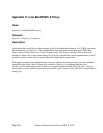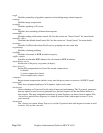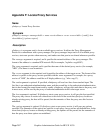Proxy Manager Config File
The proxy manager maintains a local configuration file describing the proxy services available. This
configuration file is installed in /etc/X11/proxymngr/pmconfig during the installation of proxymngr. The
location of the configuration file can be overwritten using the -config command line option.
Aside from lines starting with an exclamation point for comments, each line of the configuration file
describes either an unmanaged or managed proxy service.
For unmanaged proxies, the format is:
<service-name> unmanaged <proxy-address>
<service-name> is the name of the unmanaged proxy service, and must not contain any spaces; for
example, LBX. service-name is case insenstive.
<proxy-address> is the network address of the unmanaged proxy. The format of the address is specific
to the <service-name>. For example, for the LBX service, the <proxy-address> might be lbx.x.org:100.
If there is more than one entry in the config file with the same unmanaged <service-name>, the proxy
manager will try to use the proxies in the order presented in the config file.
For managed proxies, the format is:
<service-name> managed <command-to-start-proxy>
<service-name> is the name of the managed proxy service, and must not contain any spaces, for
example LBX. service-name is case insensitive.
<command-to-start-proxy> is the command executed by the proxy manager to start a new instance of
the proxy. If <command-to-start-proxy> contains spaces, the complete command should be surrounded
by single quotes. If desired, <command-to-start-proxy> can be used to start a proxy on a remote
machine. The specifics of the remote execution method used to do this is not specified here.
Graphics Administration Guide for HP-UX 10.20
Page 164


















